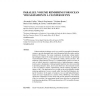Free Online Productivity Tools
i2Speak
i2Symbol
i2OCR
iTex2Img
iWeb2Print
iWeb2Shot
i2Type
iPdf2Split
iPdf2Merge
i2Bopomofo
i2Arabic
i2Style
i2Image
i2PDF
iLatex2Rtf
Sci2ools
GEOINFO
2004
2004
Parallel Volume Rendering for Ocean Visualization in a Cluster of PCs
Volume rendering techniques can be very useful in geographical information systems to provide meaningful and visual information about the surface and the interior of 3D datasets. For ocean visualization, in particular, volume rendering techniques improve the analysis of the ocean inner structure, by generating visual information about, e.g., its temperature, salinity, velocity and mass. The rendering of huge datasets, however, is a computationally intensive task and, in order to achieve interactive visualization times, a high-performance computational system is fundamental. Although parallel machines have been successful in providing interactive times, most recent efforts have been directed towards a more cost-effective solution: implementing volume rendering algorithms on clusters of PCs. This platform has low-cost and can be easily upgraded. Parallel rendering applications, however, usually suffer from high load imbalance during the execution. In this paper, we propose a low-cost an...
GEOINFO 2004 | GEOINFO 2007 | Ocean Visualization | Volume Rendering | Volume Rendering Techniques |
| Added | 30 Oct 2010 |
| Updated | 30 Oct 2010 |
| Type | Conference |
| Year | 2004 |
| Where | GEOINFO |
| Authors | Alexandre Coelho, Marcio Nascimento, Cristiana Bentes, Maria Clicia Stelling de Castro, Ricardo C. Farias |
Comments (0)

